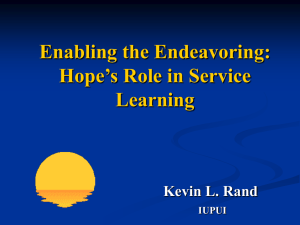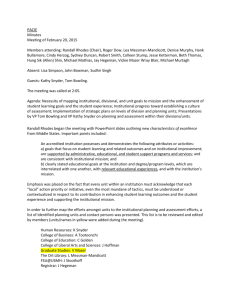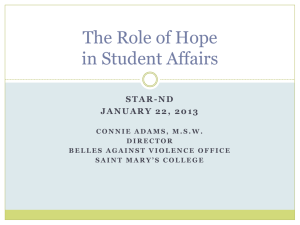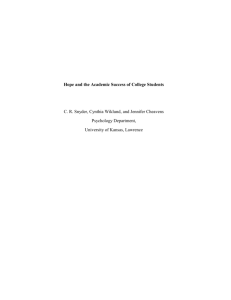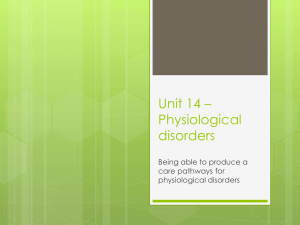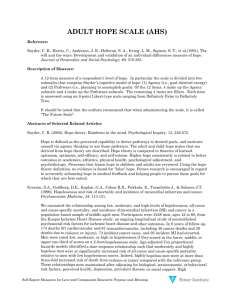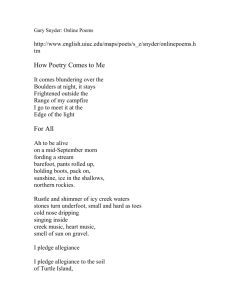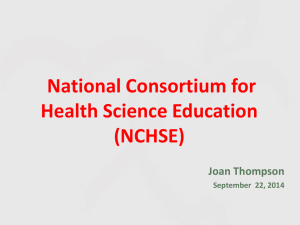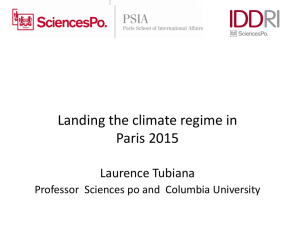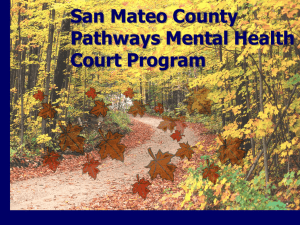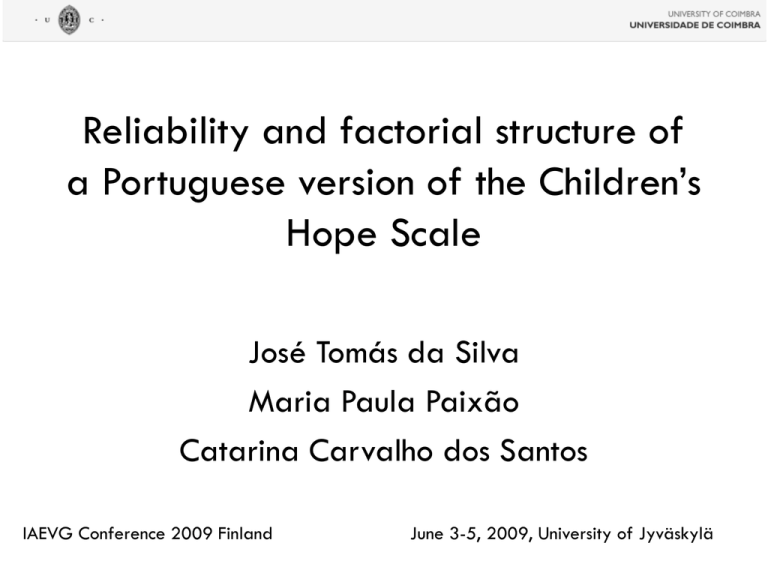
Reliability and factorial structure of
a Portuguese version of the Children’s
Hope Scale
José Tomás da Silva
Maria Paula Paixão
Catarina Carvalho dos Santos
IAEVG Conference 2009 Finland
June 3-5, 2009, University of Jyväskylä
Topics
•
•
•
•
Context of the research
Snyder’s Hope theory
Measuring Hope
Psychometric analysis of the Children’s Hope
Scale – Portuguese version
• Implications of the results for the research and
intervention on guidance and counseling in
school settings
2
Context of the research
• Team interest’s are focused on the study of Vocational
& Academic Behavior and Development from a
holistic, systemic (relational) perspective
• Master Program (University of Coimbra) - “Vocational
Development Psychology”
• Catarina Santos (co-author) proposed to study the
role of
• Patterns of Adaptive Learning,
• Hope,
• Career Attitudes
on the school achievement of 3rd cycle, Portuguese
students.
3
Context of the research – continuation
• Catarina Santos (2008) results showed that the
variables that correlated more strongly with the
levels of academic achievement were:
–
–
–
–
–
Hope,
Academic self-efficacy,
Self-handicapping strategies,
Mastery goal orientation,
Career attitudes
4
Context of the research – continuation
• Pattern of correlations: PALS scales vs. Hope
5
Context of the research – continuation
• (Standard) Multiple Regression results:
•R = 0,497; F (8, 567) = 23,23, p < 0,01
Largest Beta coefficient
6
Reasons for the present study
• To explore deeply the metrological properties of
the Children’s Hope Scale
•In particular we intended to test the hypothesized
measurement model of the CHS
•Two latent factors (agency and pathways), with
three indicators each;
•The latent variables are correlated with each
other.
7
Snyder’s Hope theory
• The Hope model was developed in the late
80’s by C. R. Snyder and colleagues, and was
updated and refined several times
• Hope is a core construct of the positive
psychology framework
• Hope is a strength-based construct
• Hope was first viewed mostly as a cognitive,
motivational model
8
Snyder’s Hope theory – range of
application
• The Hope model has been applied to various
domains:
– Views about self and the future (e.g., self-esteem, selfworth; optimism);
– Achievement in academic and athletic domains (e.g.,
anxiety in competitive, test taking situations; scholastic
competence; higher overall grade point averages);
– Connections with other people (e.g., social competence;
interest in the goal pursuit of others);
– Health and well-being;
– Work and vocational issues (e.g., Juntunen & Wettersten,
2006; developed and validated the Work Hope Scale)
9
Definition of Hope
• “Hope is a cognitive set that is composed of a
reciprocally derived sense of successful (a) agency
(goal directed determination) and (b) pathways
(planning of ways to meet goals)” (Snyder, Harris, et
al., 1991, p. 570)
• Hopeful thinking always includes three components:
– Goals
– Pathways
– Agency
10
The three components of hope
• Goals
– “Hoped-for ends. (…) Is anything that an individual desires
to get, do, be, experience, or create.”
• Pathways (thoughts)
– “Reflect a person’s perceived capacity to produce cognitive
routes to desired goals.”
• Agency (cognitions)
– “The thoughts that the people have regarding their ability
to begin and continue movement on selected pathways
toward those goals.”
(Snyder, 2002).
11
Snyder’s Hope Model
Extracted from: Snyder, C. R. (2002). Hope theory: Rainbows in the mind. Psychological Inquiry, 13, p. 254.
12
Measuring Hope
•
•
•
•
Trait vs. State
Various levels of abstraction
Qualitative vs. Quantitative approaches
Quantitative approaches are more
prevalent in the literature
13
Self-report measures of Hope
• Snyder et al.
• Hope Scale (Adults)
• State Hope Scale (Adults)
• Children’s Hope Scale
• Other researchers
• Domain Specific Hope Scale (Sympson, 1999)
• Work Hope Scale (Juntunen & Wettersten,
2006)
14
Children’s Hope Scale
• Trait hope measure for children;
• Can be applied for children ages seven
through 14 years;
• Includes three agency and three pathways
items (next slide);
• Uses a six point (1=None of the time; 6=All of
the time) Likert-type answer format;
• Has demonstrated satisfactory psychometric
properties.
15
Children’s Hope Scale -items
16
Results
• Sample (N = 576); Age (M=13,6; SD = 1,14)
17
Descriptive Statistics: Pathways, Agency,
and Hope Total Score
18
2 (sex) x 3 (school grade) MANOVA:
Pathways, Agency, and Hope Total
Multivariate Testsc
Effect
Intercept
sex
school grade
sex * school
grade
Pillai's Trace
Wilks' Lambda
Hotelling's Trace
Roy' s Largest Root
Pillai's Trace
Wilks' Lambda
Hotelling's Trace
Roy' s Largest Root
Pillai's Trace
Wilks' Lambda
Hotelling's Trace
Roy' s Largest Root
Pillai's Trace
Wilks' Lambda
Hotelling's Trace
Roy' s Largest Root
Value
,960
,040
24,102
24,102
,010
,990
,010
,010
,006
,994
,006
,006
,007
,993
,007
F
6857,023a
6857,023a
6857,023a
6857,023a
2,800a
2,800a
2,800a
2,800a
,836
,835a
,835
1,657b
,982
,981a
,980
,005
b
1,409
Hypothesis df
2,000
2,000
2,000
2,000
2,000
2,000
2,000
2,000
4,000
4,000
4,000
2,000
4,000
4,000
4,000
Error df
569,000
569,000
569,000
569,000
569,000
569,000
569,000
569,000
1140,000
1138,000
1136,000
570,000
1140,000
1138,000
1136,000
Sig.
,000
,000
,000
,000
,062
,062
,062
,062
,503
,503
,503
,192
,416
,417
,418
2,000
570,000
,245
a. Exact statistic
b. The statistic is an upper bound on F that yields a lower bound on the significance level.
c. Design: Intercept+sex+school grade+sex * school grade
19
Reliability estimates (internal
consistency)
•Total sample (N = 576)
•Pathways:
Cronbach’s alpha = .74
•Agency:
Cronbach’s alpha= .70
•Hope Total: Cronbach’s alpha = .81
20
Confirmatory Factor Analysis of the
Hypothesized dimensional model
21
Model Fit Summary
22
Standardized coefficients (loadings*)
*boldfaced (“regression”) coefficients
23
Conclusion
• CHS produces scores that have reasonable
good internal consistency reliabilities
• The hypothesized two factor, correlated model
fit reasonably well with our data
• No gender differences were found
• No grade differences were found
24
Implications for guidance and
counseling in school settings
• Further research
– The CHS scores may add unique information about
the willingness of a person to pursue goals, beyond
for example, self-efficacy beliefs, and other
constructs (interests, optimism; abilities)
– The CHS can be used to evaluate pre/post gains in
students hope, after some planed intervention
25
Implications for guidance and
counseling in school settings
• Interventions
– Assessing hope
– Developing/nurturing hope
• a) helping students to set goals; (b) helping students to
develop pathways thinking; (c) helping students to
enhance their agency (e.g., Snyder’s et. al., 2003);
• See also Snyder (2003, Journal of Counseling and
Development), and Pedroti, Edwards, et al. (2008)
description of the Making Hope Happening Program
(Professional School Counseling)
26
THANK’S FOR YOUR ATTENTION
jtsilva@fpce.uc.pt
27

